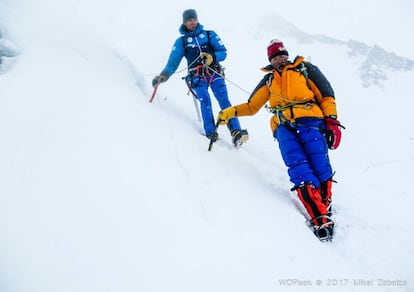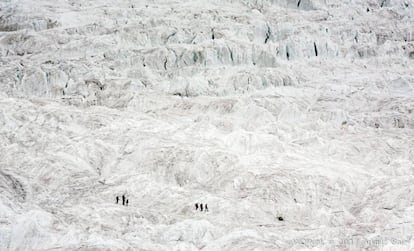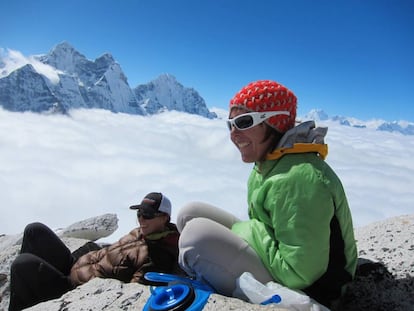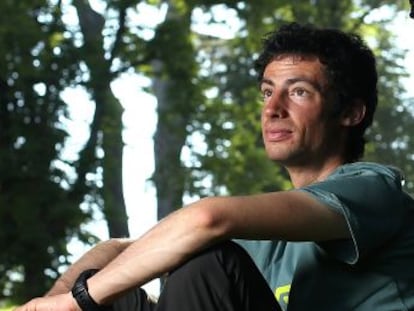Spanish climbers pull off miraculous rescue of Italian on Himalayan mountain
Expert guides Alberto Iñurrategi, Juan Vallejo and Mikel Zabalza save life of man who had been stranded for four days
While in the Himalayas earlier this week, Spanish mountain climbers and expert guides Alberto Iñurrategi, Juan Vallejo and Mikel Zabalza had something special planned: they wanted to trek from the Gasherbrum peak (8,080 meters) to Gasherbrum II (8,035 meters), without passing by the base camp, and taking a different route from the usual. On Sunday they realized they wouldn’t be able to manage such a feat. But over the next few days, they would achieve something much more important, something invaluable: they saved the life of an Italian climber who had been left stranded at an altitude of 7,100 meters.

The three veteran climbers were in the area as part of their “Al ochomil en ocho pasos” (To the eight-thousand meters in eight steps) expedition, which they are undertaking for their Walk On Project (WOP) Foundation, an organization that sees “mountain climbing as a school of life, in which commitment, tenacity, effort and emotion” are key, according to their website.
On Monday, while they were dealing with the disappointment of not managing to complete their chosen route, the team coincided with a group of climbers that were descending from the peak of Gasherbrum II, via the usual route. They were members of a commercial expedition – climbers who usually do not know one another, but jointly pay for the permission to go up to the summit, as well as for food services and porters. And unfortunately, this group had had to leave one member behind: 59-year-old Italian climber, Valerio Annovazzi.
The Italian had difficulties talking and was not making sense – symptoms of swelling of the brain
The group explained they had seen him alive at an altitude of 7,100 meters, but that he had difficulties talking and was not making sense – symptoms of swelling of the brain. Thanks to the telephoto lens of the WOP expedition photographer, Vallejo and Zabalza could see that the Italian’s tent was still up, and they decided to go in search of him at midnight on Monday, after taking a brief break to recover from their descent.
After 12 hours of slog, they managed to reach Annovazzi’s tent, giving him supplies, hydrating him and administering him medication. They immediately took him down to Camp 2, at 6,500 meters, where they all spent the night. Annovazzi, who had reached the summit, had not eaten or had anything to drink for four days, and was suffering from frostbite in his extremities. Unwilling to leave Camp 3, he was waiting for death, or for a miracle. Fortunately for him, he got the latter.

The description from Mikel Zabalza via telephone of what happened is startling.
“Valerio was almost frozen to death when we found him. I don’t think he would have lasted another day. A doctor from the base camp explained to us how to give him dexamethasone [used to treat brain swelling] and with this medication and three liters of water the man came around. He had tried to come down by himself but he had no strength, and there is steep drop from Camp 3, and he had no fixed line. He was afraid that he would fall, and he tried it three times but had to come back, with no strength at all, to his tent.”
Valerio was almost frozen to death when we found him. I don’t think he would have lasted another day
Rescuer Mikel Zabalza
As he was unable to walk, they lowered him down with their ropes, something that took hours of effort.
By Tuesday, Annovazzi was able to get to his feet, and the three climbers used roping techniques to ensure the safety of the group and slowly started to walk down to the base camp. From Camp 1 to the base camp there were still nine kilometers of glacier to go – it wasn’t steep, but it was full of cracks. “Even though Valerio could walk, he was going so very slowly, and we had to stop constantly,” explains Zabalza.
“No helicopter could have reached us in those weather conditions,” explains Juan Vallejo. “For us this is the epitome of the mountain climbing that we believe in. We’re happy because this is the best of the peaks. Life is a much more important summit. After the disappointment of the expedition we are hugely satisfied,” says Mikel Zabalza.

No doubt Alberto Iñurrategi was thinking about his brother Félix, who disappeared on the same mountain in the year 2000. He no doubt smiled to find himself in this situation, with its ironic twist of fate.
The type of climbing in which the trio believes is one that explores alternative paths, even though “that might mean that when you leave the normal route and choose another, your chances of reaching the summit fall by 70%.” The type of climbing in which they believe defends the values of the rope team: everyone goes up and everyone goes down together, they work as a team and everything is decided on as a group. The mountainside is not a battleground that allows for disorder, and three people working together are much stronger than three people thrashing around separately. For now, all of them would rather pass over a fact that, unfortunately, is all too common on mountains that are higher than 8,000 meters: that descents are usually a free-for-all that see the weakest left to fend for themselves.
Iñurrategi was no doubt thinking about his brother Félix, who disappeared on the same mountain in the year 2000
“Yes, it’s a story that you see happen again and again,” says Zabalza. “We understand the mountain from its noble side, and we will never get used to this kind of behavior. We knew Valerio from seeing him at base camp, so when we realized that he might be alive, we didn’t think twice. How were we going to abandon him?” he asks, adding that he felt “very hurt by the attitude of many mountain climbers who didn’t even stay at Camp 1 to give us a hand with the descent.”
The history of Himalayan climbing contains beautiful stories of solidarity and some lamentable examples of selfish behavior. Valerio Annovazzi has seen the two extremes.
English version by Simon Hunter.









































